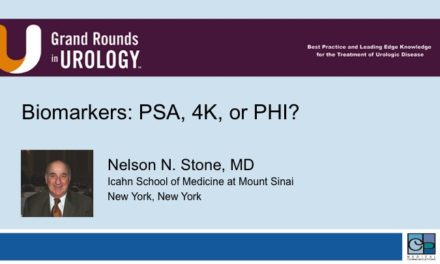Dr. Daniel P. Petrylak presented “Novel Biomarker-Guided Treatment: PSMA, PAR, HDACs, etc.” at the 27th annual International Prostate Cancer Update meeting on Thursday, January 26, 2017.
Keywords: prostate cancer, BRCA, castration-resistant, DNA, docetaxel, HDACs, olaparib, PARP, PSA, PSMA
How to cite: Petrylak, Daniel P. “Novel Biomarker-Guided Treatment: PSMA, PAR, HDACs, etc.” January 26, 2017. Accessed Dec 2024. https://dev.grandroundsinurology.com/novel-biomarker-guided-treatment
Transcript
Novel Biomarker-Guided Treatment: PSMA, PAR, HDACs, etc.
So to first start off, we basically divide this talk into three different sections. We’re going to talking about PARP inhibitors in prostate cancer. I think this is one of more exciting areas, since we’ve identified a target, we’ve identified patients with prostate cancer who may benefit. So this is really the crux of the matter with PARP inhibition, DNA repair is an important factor that’s involved. There also could be transcriptional regulation. This again is targeting DNA, and the PARP inhibitors will effect this particular area.
So what are we looking at in terms of PARP inhibition? Why is this important? Well if there’s a DNA mutation, in other words, if there’s a break that’s involved, or at least a situation, so if there’s a situation where we have a genetic abnormality in DNA repair, in other words, something like BRCA where we can’t repair double-stranded DNA breaks this can effect recombination and repair in the double-stranded pathway. If we inhibit the single-stranded pathway with something like a PARP inhibitor, which is important to single-stranded breaks, we then find a patient who would be sensitive to this particular drug. So both pathways are shut off. So normally without the PARP inhibitor you would have normal DNA repair, because you’re going by the single-stranded pathway, double-stranded pathway being active, both of these blocks are lethal to the cell.
So this has been looked at in terms of ovarian cancer, BRCA positive mutation carriers have been identified in ovarian cancer, and the FDA has approved a drug called Lynparza to treat ovarian cancer. And this is a PARP inhibitor.
So what about the data in prostate cancer? This is a paper from Dr. Matteo from the New England Journal of Medicine where they demonstrated that in patients with DNA repaired deficits that Lynparza, olaparib is active in these patients.
So overall there were 49 patients entered in this small phase 2 trial who had metastatic castration-resistant prostate cancer. These patients were resistant to docetaxel. Overall 32% of unselected patients, 16 to 49, has responses to Lynparza. And when they started doing genomic analyses of these patients they found that those who had mutations in DNA repair overall there were 16, 33% had mutations. And of those, the remaining patients, 67% had no mutations. Of the 16 patients with identified mutations 14 of those 16 patients responded to olaparib. And of the patients who no mutations 2 of the patients responded, which again I think points toward this fact of heterogeneity and selecting the right lesion to biopsy, because I would bet that these patients had in the lesions that the target lesions, that they had the mutations.
So these are the types of DNA repair mutations that were noted in these patients, BRCA was present, ATM was present, about overall so this is a mixture of different DNA repair enzymes. So this has been designated as a breakthrough therapy by the FDA for resistant prostate cancer.
So there are other trials that are being performed in prostate cancer, both as single agent or in combination. And I think they’re showing some important marker observations. Firstly, Maha Hussain, our good friend who is now the Northwestern University, she moved from Michigan to the University of Chicago, looked at combining veliparib plus temozolomide, which is an alkylating agent just like Cytoxan, and there’s some small single agent data of temozolomide in prostate cancer. But what was interesting was when they looked at this in preclinical models. This is the vehicle, this is temozolomide by itself, and this is the PARP inhibitor plus temozolomide, look at how different or how much cooler these lesions are compared to the single agents. And again, you see synergy between the two different agents when you administer these two to animals who have prostate cancer cells implanted in them. So it makes sense, of course, to go forth with this in patients. And in the combination she found that there PSA responses with this particular combination. And so it does seem to at least have some degree of synergy. Of course, you need a large randomized phase 2 to look at this.
She also was interested in the observation that the PARP inhibitors may actually be more sensitive, or the ETS repair pathway, gene pathway may actually mark sensitivity to PARP inhibitors. So this was a large randomized phase 2 trial that she performed. And this again was based upon the fact that AR signaling and DNA damage repair may be synergistic. So she looked initially at animal models to see if this seemed to be reasonable to go forth with. And so PARP inhibition will add to castration in mouse models with prostate cancer. Is the vehicle, this is a PARP inhibitors by itself, this is the combination of the two, also castration by itself. So we see that there is at least an additive effect of the two.
And when you start looking at ERG positive xenographs, remember ERG is the product, the gene product of TMPRSS2-ERG which is a fusion gene product, which is identified in prostate cancer. It’s a hormone sensitive gene. We see that these xenographs are sensitive to the PARP inhibitors. So it was preclinical justification for going forth with this.
So this trial was designed to look at biomarkers. So what they did was they registered patients, they had to have metastatic tissues biopsied prior to entry. If they did not have sufficient tissue at entry they were not eligible. They were stratified based upon ETS status and then were randomized to receive abiraterone plus prednisone or abiraterone plus prednisone, plus niraparib, which is a PARP inhibitors.
So let’s walk through the data from 148 patients that were entered on the trial. This is all patients. They were looking to see a 20% improvement in response rate for all patients. They really didn’t see it. Single agent, 64% by PSA, combination agent 71%, so 7% difference. Here it’s about a 10% difference if you look at measurable disease.
If you start looking at ETS positive and the ETS negative it really doesn’t seem to be much of a difference at all. Arm A, arm B, it’s a 10% difference and the negatives it’s about an 11% difference. The same thing with soft tissue, so this really doesn’t mark for anything significant. So again, the significance is nil in the different arms.
So they then analyzed the specimens that they had for DNA repair defects. And overall a quarter of the evaluable specimens, and look again, remember they had to have a evaluable tissue to go in, look how many patients you lost. This shows you how difficult it is to do these types of studies. So a quarter of those patients had mutations in the DNA PARA pathway, predominantly BRCA2, but BRCA1, ATM, FANCA and PABL2, so it’s about a quarter of all patients.
So let’s look at the data in terms of the DNA repair, PSA response rate overall for this subgroup of patients, 57% versus 71%, maybe a little bit more a difference. When you start looking at those that are DNA repair deficient for both Zytiga as well as for the combination, it’s a lot higher response rate, but it’s a small N. And then those that are wild-type you really didn’t see that high response rate, but there did seem to be at least an additive effect from the PARP inhibitor. So there did seem to be an improvement in progression-free survival in those patients who were DNA repair damage versus the wild-type, 13.8 versus 7.8 months. So this is moving into a larger phase 3 trial that’s going to evaluate whether PARP inhibition plus abiraterone is better than PARP inhibition alone.
So these are some of the trials that out there at this particular point. Olaparib is looked at in high-risk prostate cancer, but before radical prostatectomy, it’s a biomarker driven trial. There’s another drug called rucaparib, which is made by Clovis. This is being looked at in repair deficient metastatic castration-resistant prostate cancer in TRITON 3, and also in all-comers which are BRCA1 and 2 positive for ATM in the TRITON 2 then TITRON 3 trial. And olaparib is being looked at in metastatic castration-resistant prostate cancer. It’s the primary endpoint is response rate. Olaparib is being combined also with the checkpoint inhibitors, pembrolizumab plus olaparib, pembrolizumab plus docetaxel/prednisone, pembrolizumab plus enzalutamide in this three-arm trial. And again, this is also being looked at with nivolumab in phase 1 studies in combination in lung cancer, breast cancer and castration-resistant disease. So think that this is going to be an exciting area, and this is the reason why, right at the beginning of castration-resistant it’s important to do next generation sequencing.
So what about PSMA? This has been around for quite some time. PSMA, as you know, is an integral membrane protein. It’s expressed in about 90% of prostate cancer specimens. It may be hormonally regulated, or at least seen at a higher rate in more aggressive tissue, and it is different and distinct from PSMA, it’s homologous to a folate transport protein. So it’s been exploited for a number of years with monoclonal antibody study, it’s been linked to other anti-tubulin agents, but there are three approaches now which I think are fairly interesting.
One is combing a—at least using a nanoparticle which has a ligand which targets PSMA, and within this nanoparticle is docetaxel. It’s a way of smartly delivering chemotherapy to a cancer cell. Another way of doing this is actually using a molecule that goes in through the pore that’s made by PSMA and is transported into the prostate cancer cell. This is EC1169, and this is linked to an anti-tubulin agent called tubulysin. So once this gets into the prostate cancer cell it gets cleaved and the tubulysin combined tubulin, tubulysin is fairly toxic drug. If you’re giving this by itself you really can’t achieve levels that would be significant for the prostate cancer cells.
And then ADC approach, which we talked about yesterday in bladder cancer, which is combing PSMA plus MMAE, which is an anti-tubulin agent. Once this binds to the prostate cancer cell it’s internalized and then it’s cleaved in the lysosome by the cathepsin B and you have free moiety which then goes to tubulin and causes its anti-tubulin effect. Again, this drug, if you administer the naked drug to patients you can’t achieve levels that are significant for cytotoxicity of the tumor cells.
So Ben014 had been evaluated in chemo naïve prostate cancer cells. As I mentioned before, it’s polymeric nanoparticle, it’s loaded with docetaxel. It has reduced clearance in volume of distribution, and in phase 1 60 mg/m2 was the recommended phase 2 dose.
So this has been a little bit disappointing, because the PSA response rates that we are see are really not about the same as what you would expect with docetaxel; 30% objective response rate, about 21%, you can see about 40% with docetaxel by itself. And the CTC conversion rate is 50%. So I don’t think that this is really a quantum leap from what we see from other taxane agents. It was well tolerated, it met the study endpoint with 30 having a progression-free survival of more than 6 months, 21% response rate by resistance. I mentioned before, 30% by PSA, and then the CTC conversion rate was 50%.
Now, one of the things we’re doing with this interesting agent, the EC1169 is we’re using the ligand to image patients prior to going on study. We don’t know if this imaging is going to be predictive of response in these patients, but you can use this small molecule as an imaging agent, and again, visualize the areas in the patients that have PSMA. And some of the scans have been quite impressive.
So then we’re using, as I said before, linked to the tubulysin as a therapeutic agent and eventually we hope to correlate response with the imaging. This certainly has advantages over circulating tumor cells or immunohistochemistry, because of course you’re seeing things in real and can sequentially image these patients with the agents.
So right now we’re in a phase 1 mode for this compound. One of the reason why this phase 1 trial is taking so long is there was cardiac toxicity noted in dogs, and it was the FDA basically telling us that we really shouldn’t go too quickly with it. So we’ve looked at two different schedules and we finally have arrived upon the weekly schedule rather than a three times a week schedule. It’s almost impossible to get patients in for this. And in a very small preliminary study that we reported at the ESMO meetings back in the fall we see that nausea is the predominant side effect with this particular drug. And we are seeing some PSA declines with it. So this in the preliminary stages and again, we may see some activity, but we have a ways to go in our accrual.
I mentioned before that the PSMA targeted therapy that we had worked, Neal has also participated in these trials, has shown some activity. And again, this is a conjugate that’s cleaved by cathepsin B and then releases the MME moiety to attack tubulin. We’ve looked at this in two different groups of patients, and also have analyzed this in terms of both PSA and circulating tumor cells. And the PSA response rates have been modest at best, but we start enriching patients for PSMA expression on the circulating tumor cells. We see that the response rates actually increase, and they’re about 20% overall for the refractory, they’re slightly higher for the non-refractory. The major adverse events that we’ve seen with this have been peripheral neuropathy, as well as neutropenia. The recommended phase 2 dose was 2 mg/Kg. And so the overall, the PSA response rate was 14%, 21% in the chemo naïve, but the – – tumor cell responses and PSA responses were more prominent in those patients who had a high PSMA expression, as well as low neuroendocrine markers. As I mentioned before, the major side effects where neutropenia, fatigue, and neuropathy.
Raoul sort of talked about this target previously, the heat shock protein inhibitors. These are a class of targets that will effect the androgen receptor, and they actually regulate androgen receptor activity on two different levels. The first, of course, is binding of dihydrotestosterone where this, the HSP90 protein is basically ejected so that the molecule can dimerize and then complex with HSP27, this can then enter the nucleus, bind to DNA and become – – active. We see that there is a large complex that occurs in wild type, and again, with HSP70 and HSP40 as well.
So there are a variety of different compounds that are being evaluated with the heat shock proteins. Those that are targeting HSP90, basically showing a very, very low PSA response rate, and really there have not been any marker driver trials to select these.
HSP27 has been looked with an anti-sensitive compound, OGX427. Again, modest PSA response rate seen combined with docetaxel. Also, modest PSA response rates seen when this is combined with prednisone. So this is again I think a little bit disappointing in its overall PSA response rate, but these are first generation drugs which, of course, need to be refined.
Clusterin has also been targeted. This is a protein that’s present in prostate cancer cells in the nucleus. It’s upregulated with castration. As we know, both of the trials that were looked at in terms of chemotherapy combing anti-clusterin antisense in the docetaxel naïve patients, as well as those patients who were refractory to docetaxel, combing with cabazitaxel did not show a significant improvement in survival.
So those are the areas that we were looking. I think that was have a lot of work to do as far as our markers are concerned, and certainly the phase 3 trials are now underway, as I’ve outlined. And we certainly ought to be moving forward with these new targets, as well as others.
ABOUT THE AUTHOR
Daniel P. Petrylak, MD, is currently Director of Genitourinary Oncology, Professor of Medicine and Urology, Co-Leader of Cancer Signaling Networks, and Co-Director of the Signal Transduction Program at Yale University Cancer Center in New Haven, Connecticut. He is a recognized international leader in the urology field. He earned his MD at Case Western Reserve University School of Medicine in Cleveland Ohio. He then went on to complete his Internal Medicine Residency at Albert Einstein College of Medicine/Jacobi Medical Center in the Bronx, and his fellowship at Memorial Sloan Kettering Cancer Center in New York.
Dr. Petrylak has served as principal investigator (PI) or co-PI on several SWOG clinical trials for genitourinary cancers. Most notably, he served as the PI for a randomized trial that led to the FDA approval of docetaxel in hormone refractory prostate cancer. He also helped to design and served as PI for the SPARC trial, an international registration trial evaluating satraplatin as a second-line therapy for hormone refractory prostate cancer.
Dr. Petrylak served on the program committees for the annual meetings of the American Urological Association from 2003-2011, and for the American Society of Clinical Oncology from 1995-1997 and 2001-2003. He also has served as a committee member for the Devices and Immunologicals section of the FDA. He has published extensively in the New England Journal of Medicine, Journal of Clinical Oncology, Journal of the National Cancer Institute, Cancer Research, and Clinical Cancer Research.





